Creating Temporary Organizations for Lasting Change
The 1996 Atlanta Olympic Games and Fortune 500 companies Boeing, Metropolitan Life Insurance and Supervalu are used to illustrate a novel way to drive major change initiatives throughout an organization. By creating a temporary organization or team, as the model is called, a company combines enough human energy and resources to infuse the kind of large-scale change that cannot be accomplished by one person alone, not even the C.E.O.
Logical in concept as the temporary organization is, it is nevertheless distinctive because its success lies in becoming a genuine extension of the C.E.O. ¬ a "clone," if you will. In other words, the temporary team provides both the day-to-day and big-picture view that a C.E.O. would use to drive results. This not only requires clearly established objectives but also an effective internal communications process. It is also important to place the temporary organization outside the current corporate structure. Otherwise, it will risk becoming immobilized by the natural resistance to change. Operating from this independent vantage point, the team goes for "quick wins," or rapid success stories, to establish momentum, to build confidence with the board and to demonstrate the serious nature of the change program. As the program broadens out into all of its component parts ¬ from setting up work guidelines and providing training to tracking progress and measuring results ¬ the team serves to amplify the reach and vision of the C.E.O. throughout the organization.
The case studies stress the design considerations of the "temporary organization" approach, and show how it can be effectively employed in any company to foster dramatic and long-term improvement in operating performance.
In addition to a summary of best practices, the article offers a list of common mistakes that can damage the prospects for a successful outcome. Finally, Metropolitan Life Insurance's transformation program, MetLife Express, is highlighted in an accompanying sidebar.
Faced with a rapidly evolving competitive marketplace, the chief executives of many of today's leading companies have embarked on major change initiatives. The goal is twofold: to challenge the existing ways of conducting business and to drive step-level improvements in operating performance. The method is two-pronged as well: cut costs significantly and build capabilities to better serve the marketplace. These initiatives, then, often involve the radical redesign of the very systems and processes that the companies rely upon to develop, deliver and service the products they provide.
Trying to remake the organization to compete more effectively while continuing to serve customers thus presents a significant management challenge, one of the key reasons behind the widely cited 70 percent failure rate of major re-engineering initiatives.
This article explores a novel way to meet that challenge, by driving significant companywide change through the use of an innovative transforming vehicle, the "temporary organization." Small in size yet acting with the full authority of the C.E.O.'s office, such organizations are set up and staffed with the sole goal of revamping the status quo as quickly, painlessly and thoroughly as possible. They accomplish all this by acting outside the normal boundary lines of the existing corporate structure and by being liberated from the day-to-day agenda and concerns of the business.
How this approach can drive step-level changes in costs, while at the same time permitting more effective responses to customer needs, is discussed through case studies of three Fortune 500 companies. We have partnered with these companies -- Boeing, Metropolitan Life Insurance and Supervalu -- in such efforts.
The cases highlight the design considerations of this approach, and show how it can be effectively employed in any organization to foster dramatic and long-term improvements in operating performance.
An Olympic Challenge
When considering the issue of how to drive significant change, there is perhaps no clearer example than the Atlanta Committee for the Olympic Games (ACOG), the organization that directed the preparations for the 1996 Summer Games. When the Games ended, Atlanta had a rich legacy of new capital improvements, including a huge stadium, more than 9,000 college dormitory rooms and arenas scattered throughout the city -- all construction projects that the committee had managed. More than 3 billion people worldwide viewed the events, which had been staffed with 30,000 paid workers and 40,000 volunteers, all supervised by the committee. But while ACOG worked closely with the city government, it was in fact a separate organization, chartered by the city to function only until the Games were completed.
This approach to preparing for the Olympics was not unique to Atlanta; both Barcelona, in 1992, and Los Angeles, in 1984, employed similar organizations.
The use of these "temporary organizations" grew out of the realization that government bodies responsible for the day-to-day maintenance of a city are not set up to handle the once-in-a-lifetime business of preparing for such a major event as the Olympics. This realization -- that existing organizational structures are ill-equipped to drive step-level change -- is the key to understanding how a C.E.O. can implement an effective transformation process.
As reported in the business press, ineffective efforts are legion: a significant number of change programs stall shortly after they begin or simply fail to deliver the anticipated results. In many cases, the C.E.O. had a clear vision; he or she understood the issues in the competitive environment, and could clearly articulate the need for change. However, unlike the Atlanta committee, the C.E.O. appeared to lack the tools to translate that vision into actions that would mobilize change. Somewhere between the C.E.O.'s communication of the desired end-state for the company and the many daily actions of the company's workers, change failed to occur.
We believe this is because C.E.O.'s are asking their companies to embrace and manage significant and discontinuous change when those organizations are largely capable of making only incremental improvements. This is akin to asking a city government, an organization used to building roads, to construct and manage new stadiums and Olympic venues.
Simplifying Complexity
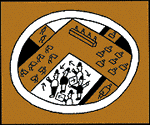 The dramatic redesign of a company's business systems and processes is a significant task, which eventually requires the understanding and involvement of many, if not all, of the organization's employees. In numerous cases, an objective of the change process is to refocus the culture of the company to become more oriented to the customer and to performance. To accomplish this task requires more energy than the C.E.O. can personally direct.
The dramatic redesign of a company's business systems and processes is a significant task, which eventually requires the understanding and involvement of many, if not all, of the organization's employees. In numerous cases, an objective of the change process is to refocus the culture of the company to become more oriented to the customer and to performance. To accomplish this task requires more energy than the C.E.O. can personally direct.
How then do the C.E.O. and the top management team of a large company create an extension of themselves to communicate and drive change into, and across, the organization? Until genetic engineering allows for the cloning of chief executives, how can they duplicate the kind of deep personal impact they might have in much smaller companies?
One answer that has proved successful in several companies is to create a temporary team that is the corporate version of the special model used by cities to prepare for the Olympics. For example, when the chairman and chief executive of Metropolitan Life, Harry Kamen, launched a major change initiative in 1994, he created MetLife Express, a temporary team charged with the task of driving change throughout the company.
Mr. Kamen's initiative was sparked by his recognition of the need to confront a number of challenges, chief among them the increased competition in the financial services industry. The role of the MetLife Express team was to "align the organization" by getting the C.E.O.'s vision, message and sense of urgency across to all corners of the company. The team's mandate was to amplify and focus the energy required to drive the fundamental redesign of critical business processes, like product development and customer service. The team's guidepost was MetLife's vision of leadership in helping people become financially secure.
In the early stages of a C.E.O.-driven initiative, the temporary team acts as top management's vehicle to prepare the organization for change. Later, it serves as a mechanism to drive employees to accept and implement the new ways of operating. Companies that have successfully employed this model have created the temporary team outside of their regular structure, making it possible to reach across the organization to identify and address high-impact opportunities.
The team -- which can consist of many interdisciplinary sub-teams, whose aims are to address specific transformational tasks, processes and functions, such as improving customer service or enhancing performance measurement -- is not a replacement for the C.E.O. and top management, however, but merely an effective tool to drive their agenda to completion. The strategic imperatives of what needs to be changed should be shaped by the C.E.O. and the top managers, and then handed over to the temporary team and its sub-teams for implementation.
To insure success, however, the top executives need to be involved in structuring and driving the change process itself, for without their focused effort and support the organization will not embrace the process and the end goals will not be reached. Through continued visible support from the C.E.O., the temporary team builds credibility within the organization, which is also essential for success. And since the team must act in partnership with the C.E.O. and top management, it needs to make sure that any outside resources it brings in to augment internal skills must join in the partnership as well.
While some companies undergoing change initiatives have attempted to integrate the functions of the temporary team into an existing structure, our research indicates that this is a flawed approach. Major change often requires the restructuring of many of the company's processes, functions, organizations and culture. Given the natural tendency of people to resist change, this appears to many in the company to be a daunting task. In fact, a significant contributor to the high failure rate of major re-engineering efforts is the inability to mobilize the company's work force to buy into change.
One key problem is the differing views of change held by senior management and the rest of the organization. Senior managers view it as an opportunity to strengthen the business, to align strategy and operations and to advance their careers, while other employees often see change as disruptive and intrusive. By creating a new organization model, the temporary team can focus on building a series of bridges across the gap between the C.E.O.'s internal vision and the natural resistance of employees and organizations to change.
Creating the Organizational Phoenix
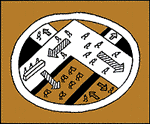 The first step in the change process is the selection of the temporary team by the C.E.O. and the top management group. To increase the probability of success, it is critically important that those selected are well respected across the organization.
The first step in the change process is the selection of the temporary team by the C.E.O. and the top management group. To increase the probability of success, it is critically important that those selected are well respected across the organization.
Harry Kamen created MetLife Express to sharply improve his company's performance and to address its cost position while building the capabilities to foster profitable revenue growth. Because of the program's importance, Mr. Kamen and his management group gave special attention to the selection of the leader of the temporary team. Eventually, they tapped three key executives to lead the initiative through its sequential phases under the overall executive sponsorship of Bob Crimmins, executive vice president. The team leaders were Dave Levene, senior vice president and chief actuary; Bill Toppeta, president and C.E.O. of Canadian operations, and Joe Reali, vice president, corporate risk management. Each of these executives was asked to lead the team through a different phase of the initiative and each served as the overall leader during that phase.
Recently, another corporate giant, Boeing, also faced competitive challenges, but of a slightly different nature. While Boeing had been highly successful historically, achieving an astounding 60-to-70 percent share of the commercial aircraft market, management recognized that the products were maturing and that it would need to transform the company to reduce the development cycle, improve manufacturing efficiency and increase the ability to deliver innovation to the marketplace.
To accomplish this, over the last several years, Boeing established a temporary organization whose task has been to address, define and control airplane configuration/manufacturing and resource management issues. Each sub-team within the organization was given objectives to radically transform the way Boeing conducted business. They were also given the goal of working together in a sequential manner, beginning with new product development, then configuration management, then manufacturing strategy and finally lean manufacturing.
To insure that the program received the appropriate amount of attention from the company, Ron Woodard, president of the Commercial Aircraft Group, tapped senior executives to lead each phase of the initiative. Mr. Woodard realized that to be successful, he would need to create a new model for the company as a whole. While the Atlanta city government continues to operate much the same as before the Olympics, Mr. Woodard knew that change at Boeing would need to be lasting.
Mobilizing the Organization
Once the key players are in place, the temporary team begins to take on the responsibility and accountability of the C.E.O. and other top executives and starts to focus on preparing the company as a whole for large-scale change.
The leader of the temporary team has three main roles to fill on the way to determining how and where to create significant value through change: 1) establishing and structuring the rest of the temporary organization; 2) bringing and maintaining an enterprise-wide perspective, and 3) building support for the change process, by coming up, for instance, with "quick wins.''
Putting together the rest of the temporary organization is a crucial initial step for the team leader. For example, Dave Levene, who led during the first two phases of MetLife Express, worked closely with the top management group to build the temporary team, looking for people to serve full time from the existing organization. Selecting the right team members was a key agenda item for the management group. After screening many candidates, they chose five sub-team leaders and more than 50 team members, all of whom were known for their enterprise-wide perspective.
It is important to note that without the direct support of the C.E.O., this important phase of establishing the temporary team would not have been successful. That is because there was an initial reluctance within the organization to release top performers for a full-time commitment of several months. To make sure that the C.E.O. remained closely linked with the initiative, Mr. Levene asked for the equivalent of 4 to 5 days a month from the top management group to review his team's progress. Top management executives were also asked to sponsor individual re-engineering teams to further demonstrate senior management's commitment to the effort.
After this step was completed at Boeing, the temporary team established the overall program structure. Team members defined the role and objectives of the senior management steering committee and developed charters for their own groups. These charters further hard-wired the C.E.O.'s objectives into the new program, which the chief executive talked up whenever he spoke at employee meetings. To strengthen those linkages, the team leaders set up reviews with Mr. Woodard and his top management group directly, meeting every couple of weeks in the early stages of the initiative. As an extension of the C.E.O., the temporary team needs reasonably frequent interactions to take direction, provide feedback and listen to recommended changes to the program's objectives.
As a last element of creating the temporary organization, the team members must establish an effective communications program to demonstrate and reinforce the C.E.O.'s vision throughout the company. The goal of the program is to move the entire company into alignment with the strategy developed by top management, building buy-in among the employees throughout each stage of the change process. As the guiding element for the program, the temporary team needs to decide how best to engage the work force. Often this includes a C.E.O. video, newsletters and external press releases.
Exhibit IMoving from Team Estimates to Management Commitments
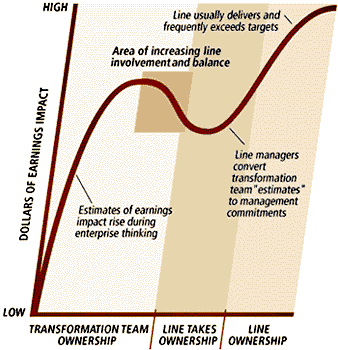
Source: Booz-Allen & Hamilton
For the kickoff of the manufacturing change program at Boeing, professional graphic artists were hired to help communicate the "as is" and "to be" models and to produce learning maps focusing on the rationale for change from the customer's perspective. At MetLife, the C.E.O. prepared a video, enabling him to directly communicate with all of the company's associates about the program. At Supervalu, videos, handbooks and meetings with industry leaders were used.
A Wide-View Mirror
Another important element in engaging the company is to bring an enterprise-wide perspective to all decisions, acting as the C.E.O. and the top managers would in analyzing and resolving an issue. The temporary team's role is to look holistically at opportunities identified by its sub-teams to insure integrated solutions for the enterprise, and to coordinate and make trade-offs to find an appropriate balance across the company. For instance, the temporary team might make decisions on balancing the issues of positioning for growth with cost reduction.
This occurred at Supervalu, America's second-largest food wholesaler, a company with more than 42,000 employees and operations in 48 states. When the chief executive, Michael W. Wright, initiated his change program, Advantage From Supervalu, in 1994, he set the goal of reducing costs throughout the company's extended supplier and customer network. That was to be accomplished by developing tailored distribution systems, building the capabilities for innovative pricing and instituting procedures to provide incentives for customers to help cut costs. These issues spilled across traditional organizational boundaries and required the temporary team to address change from the enterprise-wide perspective of the C.E.O.
The temporary team can also become the public face of change, standing in as the visible surrogates on a day-to-day basis for the C.E.O. and the top managers. Because the team members are solely focused on the change effort, and are more in touch with the detailed facts of the situation, they can be more effective at this job than the chief executive could be. And because the temporary team is outside the current organization, its members can distance themselves from past strategic commitments, which may no longer be valid, and instead push toward what is right for the enterprise.
At MetLife, for example, the team members recommended the creation of a "shared services" organization, which resulted in the consolidation of several formerly decentralized functions, including human resources, information technology and customer service. A marked departure from the past, the change enabled MetLife to realize economies of scale while improving the quality of the service provided to the business units.
Win Big (and Early)
The last important step that the temporary team must take to mobilize the company is to build successful momentum for change. It is critical to drive for "quick wins" early in the program to establish and maintain that momentum.
Quick wins are specific changes that are easily implemented and that serve as an embodiment of the characteristics of the new direction the company is taking. Many companies obtain quick wins from the outsourcing of non-critical work, resulting in lower costs and an increased focus on serving key customer needs. Boeing, on the other hand, realized quick wins by insourcing work in areas where it saw cost advantages over external suppliers.
These rapid success stories show more than plans for change. They demonstrate to everyone in the company that "we're serious this time" and that this change program will work. For the C.E.O., who is staking his success on the change effort, quick wins are key to instilling confidence in the board and the outside financial community that the effort will pay off.
The temporary team plays the central role in identifying potential quick wins and providing the resources to make them happen. These opportunities also represent "field tests" for the temporary team (and others) to learn about the overall process and the nature of resistance in introducing change throughout the company. Such lessons can be incorporated into the process moving forward.
Managing the Pulse of Change
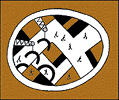 In leading major change, the temporary team must constantly monitor the pace and scope of the initiatives to keep the company aggressively stretching -- but not breaking. The team functions well as an extension of the C.E.O. here as well. Its members help resolve conflicts, push to make the tough calls and fine-tune the program based on feedback. Capitalizing on their continually growing base of experience, the team members come to understand the characteristics of achieving successful change in the company, and they have the authority and the tools to recalibrate the approach to enhance its effectiveness. Much of their feedback and experience comes from being so close to the project, living with the issues on a day-to-day basis.
In leading major change, the temporary team must constantly monitor the pace and scope of the initiatives to keep the company aggressively stretching -- but not breaking. The team functions well as an extension of the C.E.O. here as well. Its members help resolve conflicts, push to make the tough calls and fine-tune the program based on feedback. Capitalizing on their continually growing base of experience, the team members come to understand the characteristics of achieving successful change in the company, and they have the authority and the tools to recalibrate the approach to enhance its effectiveness. Much of their feedback and experience comes from being so close to the project, living with the issues on a day-to-day basis.
As an entity outside the rest of the organization, the temporary team has a special role to play to insure that the change initiative remains true to its objectives and vision. It does this by reminding the C.E.O. and other senior executives of the tough decisions that are needed to realize the program's benefits. Those decisions are usually the ones that cross the boundaries of the current organization or call for reallocating investments or expense support based on a new set of priorities.
Because of its unique positioning, the temporary team can also recognize and address the need to step up to an issue that may not have been contemplated early in the process. A good example is the need to restructure the company, from top to bottom, based on the redesign of the business processes.
Supervalu, for instance, recognized the need to combine the functions of several centralized organizations -- including merchandising, shelf management and retail pricing -- into a category management function to increase the value delivered to its customers on a regional basis. As this decision necessitated a significant organizational restructuring of the company's 25 divisions, it was critical for the temporary team to convey the recommendations of the sub-teams to senior management, and to follow up to guarantee implementation.
In another case, MetLife recognized the need to realign the company to foster the delivery of world-class customer service across product lines. As a result, two customer-focused business units were created to strengthen MetLife's ability to deliver best-in-class service by responding effectively to customers' needs. Again, as a major departure from past structures, this approach required the support and oversight of the temporary team to insure management buy-in and effective implementation.
By positioning itself in the center of the feedback loop for change management, the temporary team can serve in an arbitration role throughout the program. It can help to quickly surface and resolve disconnects in emerging recommendations or interpretations during implementation. While these issues would typically surface over time, the temporary team speeds up the change process by seeking out the issues and framing them for resolution. Given its mission of implementing successful change, the temporary team will be looking to resolve conflicts among relevant executives. But given its unique position, it can still provide a "safe harbor" by encouraging differing views and driving to an effective resolution that is best for the enterprise as a whole.
Mitigating Risk
The temporary team plays another vital role -- increasing management confidence and comfort by providing a focal point for controlling the risks of change. And the risks from poorly managed change are significant.
Without a clear objective and a well-run communications process, an organization can drift, losing track not only of where it is going, but also of how to function in the interim. In the absence of a structured communications process, the "water cooler" network can take over, resulting in increased uncertainty and lower morale. In the early stages of a change initiative, it is all too common for an organization to become too inwardly focused on the process itself, causing it to lose sight of serving its customers. This can hasten the decline of its competitive position, driving the organization in the opposite direction from the intended results.
By leading the company where it should be going, based on the initial vision of change and the continued monitoring of progress toward that goal, the team keeps things on an aggressive track while also being careful not to overwhelm the organization. To best accomplish this, the team needs to be a step ahead in setting up roles and expectations for the sub-teams. By phasing in the approach to change (from identification of detailed issues through external benchmarking and implementation planning), the team facilitates natural transitions, which enables the organization more readily to adapt to change. Functioning in this leadership role, the team provides the next level of direction, based on what has been discovered so far.
A best practice of staying ahead of the program is to identify when the improvement ideas should be fully handed over to line management for implementation. Experiences at MetLife, Boeing and other leading companies indicate that this occurs at different points for each effort.
Making It Happen
Most important, there is a need to operationalize the change effort -- to make it happen. After initiating the process by mobilizing the organization, the temporary team must make sure that actual steps are taken to achieve success, by giving direction to the organization on what to do and following up to see that the job gets done. The temporary team is the mechanism that provides the end-game view that the C.E.O. would use to drive results. By helping to structure the activities, setting up the work guidelines, providing training, tracking progress and status and measuring the results, the team serves to amplify the reach and vision of the C.E.O. throughout the organization.
At MetLife, management set expectations in terms of financial results, and provided such tools as training, specific resources and separate office facilities and computers to help the team members reach their goals. To encourage the full-time members to think in an unconstrained way, special team offices were set up across town from MetLife's Madison Avenue headquarters in New York to distance the members from their old day-to-day jobs and allow them to focus instead on the future.
Exhibit IIMetLife's sub-teams and their charters
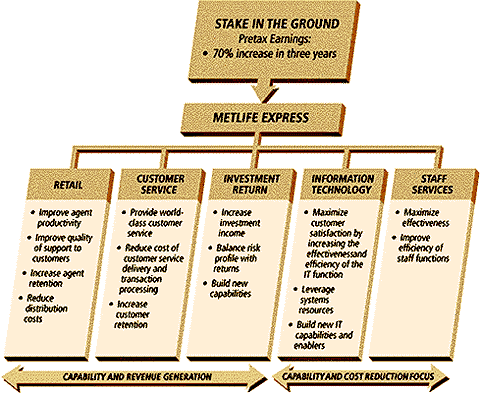
Source: Booz-Allen & Hamilton
Part of the temporary team's role was to work with established areas of the organization to help people there focus on the challenges posed by MetLife Express. The team engaged those in strategic planning to frame the future vision, those in the financial area to understand the magnitude of the challenge and people in human resources and communications to reach out to involve the broader organization.
During implementation, the temporary team helps structure activities that the company needs to perform. The team takes a long-term, overview perspective to develop a "picture" of what the end result should be. This helps drive organization discussion and buy-in. It also helps keep players oriented toward key objectives over the life of the program, so that the process doesn't go off on tangents.
Having that picture for reference enables the temporary team to insure that the program objectives are being properly addressed. From this picture, the team identifies critical path items and develops an overall plan to best address them, including establishing key milestones and deliverables to measure progress.
The team also acts as the center point for training and experience transfer. With their perspective at the apex of the change efforts, team members are able to identify and communicate best practices across the sub-teams, which increases the effectiveness of implementation. The temporary team can also educate the sub-teams and the rest of the organization about what they need to do, and provide guidelines on how to do it. By continuing to build upon its initial communication plan, and informing the organization of what actions are coming and their likely impact, the temporary team keeps the company up-to-date on what stage the change program is in and what should be expected next.
In change programs, it is likely that all the skills required will not exist or be available in the organization. The temporary team addresses this in two ways: by supplementing the core program team with external resources, to address skill gaps, and by providing training for team members to increase overall effectiveness. In working in this role, the temporary team should develop materials to reduce the learning curve for its members at key transition points throughout the program.
 When the program is in the implementation phase under line and staff management, a key role for the team is to track its status and resolve problems. In maintaining a consistent approach, the team develops standards for such key areas as status reporting, budgets and work plans so that the condition of the overall program can be easily determined. It periodically assesses that status, in review sessions and informal updates, and identifies potential problem areas. It then makes adjustments to the program to fix the problems. Issues that typically occur include misinterpreting the program's objectives and scope, underestimating the work that needs to be performed and not understanding what skills and resources will be required to accomplish the tasks.
When the program is in the implementation phase under line and staff management, a key role for the team is to track its status and resolve problems. In maintaining a consistent approach, the team develops standards for such key areas as status reporting, budgets and work plans so that the condition of the overall program can be easily determined. It periodically assesses that status, in review sessions and informal updates, and identifies potential problem areas. It then makes adjustments to the program to fix the problems. Issues that typically occur include misinterpreting the program's objectives and scope, underestimating the work that needs to be performed and not understanding what skills and resources will be required to accomplish the tasks.
The next role appears to be administrative, but this function -- coordinating and synchronizing activities across the sub-teams and the larger organization -- actually requires the temporary team to employ a leadership perspective. It is important to approach this task from the position of deciding what is the right objective for the change process, and not just by filling out a template correctly.
The temporary team must identify timing mismatches between sub-teams and propose schedules that best balance each sub-team's needs. In doing this, it must evaluate possible overlaps and gaps between sub-teams and propose areas where consolidation of activities would be beneficial, based on the perspective that the C.E.O. himself would bring to the process. The temporary team must also look outside its own activities and coordinate with other projects, to provide consistency in enterprise-wide objectives.
Lastly, the temporary team is the central focal point for monitoring the program's progress. It is therefore important to establish quantifiable measures to gauge that progress and insure that objectives are being achieved. A key initial step is to establish financial earnings objectives based on what is needed to deliver on the company's commitment to its shareholders and other stakeholders. The most effective measures combine financial tracking and well-defined program milestones and deliverables. These financial measures need to take into account external factors, such as exchange rate fluctuations or changes in market conditions.
The measurement process is not only critical for judging success or failure, but must be structured in a way to permit calibration of the results. This means, among other things, that the measurement cycle should have a tight enough time frame to highlight potential shortfalls. A best practice is to drive the measurement program into the budgets. At MetLife, when the decisions were made to proceed with specific changes, the financial impact was integrated into company business plans. Based on the anticipated improvements in line organization budgets, management reported its plans to the board.
This measurement process continually reemphasizes the need for success while also providing feedback on how the change program is going.
One best practice is for the temporary team to "keep the heat on" by serving as the C.E.O.'s conscience, insuring that financial objectives remain at the forefront. The team can accomplish this by periodically shining the spotlight on opportunities to guarantee that they do not slip away.
Teams consistently identify significant opportunities quickly, but estimates of the earnings impact typically are reduced as line managers become more involved in the groups' efforts. Our experiences show that there is typically a 15 percent to 25 percent erosion from early estimates to the point of management commitments.
But during implementation, we have also found that line managers often exceed their commitments. This basic pattern has been observed at many companies with successful change programs. However, the better result does not happen without a lot of focus and effort. When the erosion from an early estimate is initially observed, management must respond by increasing the attention and pressure on the line managers to deliver more.
Conclusion
While the change initiatives at Boeing, MetLife and Supervalu have not been without their challenges, the indications are that all three companies have been successful in reaching their initial goals.
Boeing's redesign of its product development process was applied to the recently introduced 777 airplane, which has been met with rave reviews and commercial success. Additionally, the lean manufacturing teams have implemented changes at several plants, resulting in significant savings in non-material related costs.
Due to the success of MetLife Express, MetLife has been able to position itself for growth, industry consolidation (e.g., its merger with The New England life insurance company) and international expansion.
At Supervalu, Jeff Girard, the executive vice president and chief financial officer, estimates that inventory savings alone will pay for the Advantage program.
Each of the companies has faced a tough competitive environment and each has prepared itself for the future. Like Atlanta, Barcelona and Los Angeles before them, they have built new organizational structures and driven dramatic change, thanks to a well-designed temporary team.
Exhibit IIITeam structure by phase
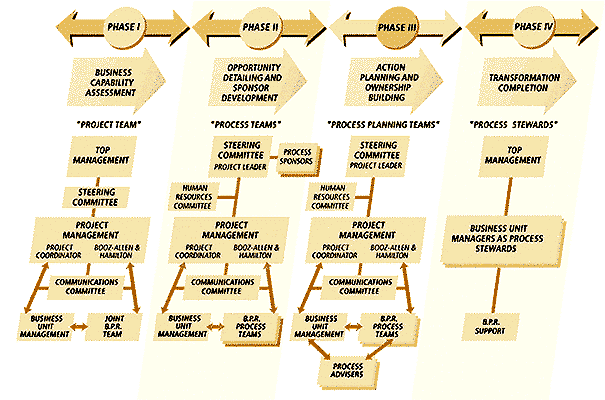
Source: Booz-Allen & Hamilton
Illustrations by Maris Bishofs
The C.E.O. and the top management group must make sure that any change initiative meets several criteria, including:
- Remaining true to the vision.
- Remaining focused on a long-term enterprise-wide view (as various potentially conflicting projects arise).
- Extending the program to the far corners of the company.
- Staying on an aggressive pace, to demonstrate results and create further incentive for change.
- Allowing the channels of feedback and communication with the C.E.O. to remain fully open, enabling modifications and course corrections.
Common Mistakes
- Once and Done -- The C.E.O. and the top executive group set up the temporary team, provide direction and then end their involvement in the change effort, having delegated ownership of the effort to the program office.
- Template Tenacity -- The leader of the temporary team keeps tight control throughout the program and views attempts by the company to take hold as a bid to sink the team's efforts.
- Maintaining Two Sets of Books -- There is a failure to incorporate anticipated benefits and costs into the normal commitment process (e.g., annual and five-year plan). By not being a part of that process, the temporary team may find that the weight of the organization is not behind it.
- Pulling the Rip Cord Too Early -- Management has the urge to "get back to normal" and asks the leader of the temporary team to return to another role in the organization too soon. Usually, there is a need to maintain a senior team role for at least one year into implementation.
- Scope Surrender -- Teams run amok as to their charter and what they are trying to accomplish. In the end, nothing gets accomplished because all the time is spent defining what they will do.
Often a disguise for non-believers. - Running for Cover -- The company allows benefits to be negotiated away as various units/individuals redefine what they do so they are not affected by the change.
Best Practices
- Choose the Program Leader Carefully -- Find someone who has the respect of the organization, is willing to make the tough decisions and can drive real change. Someone willing to take on the numerous challenges that come with leading a major program.
- Keep the Heat On -- The temporary team serves an important role in keeping the financial objectives in front of the organization and shining the spotlight on them to insure they are achieved.
- Move to the Line as Quickly as Possible -- Obtain buy-in and ownership. If the momentum is there and successes have been shown, the line will grab hold and run with it.
- Maintain the Course -- Create momentum by demonstrating success early in the program. But as the ownership moves to the line, do not let the goals get diffused over time and because there are different owners. Proactively manage and monitor the goals and be a part of the decision-making and drive as changes occur.
- Tailor the Program to the Corporate Culture -- Customize and adapt work approaches, the decision-making process, the pace of change and the nature of communications to the company's culture.
- Communicate, Communicate, Communicate -- Keep the lines of information open to the sub-teams and within the overall program and, most important, to the rest of the organization. Carefully prepare and involve those who know how to deliver the good and bad news. Recognize that the C.E.O. is the chief communicator.
- Always Stay Ahead of the Program -- Prepare/set up for each phase prior to the sub-team being ready, to insure momentum across phases and changes in ownership.
MetLife Background
In 1994, MetLife's chairman and C.E.O., Harry Kamen, launched a major effort to transform the company. The industry was confronting a number of challenges. In particular, the financial services and insurance businesses were facing increasing competition. As a result, MetLife undertook an effort to focus on its core businesses and its mission of "helping people become financially secure." It formed MetraHealth, a giant health care company, in partnership with Travelers, and subsequently sold that company. It also set in motion the largest merger of life insurers -- with The New England life insurance company. Simultaneously, as part of his overall agenda to prepare for growth in a changing industry, Mr. Kamen began a far-reaching program, MetLife Express, to improve the performance (cost, revenue and investment returns) of the core businesses.
MetLife Express was the vehicle used by the C.E.O. and his top management group for sending an integrated temporary team across traditional organizational boundaries to identify the best ideas for change. It was also used to insure that the effect of implementing the ideas on the entire enterprise was considered. The program was launched around Thanksgiving 1994 and was the primary agenda item for the C.E.O. and the top management group in 1995 and 1996. In the program's early stages, the senior management, including the C.E.O., established aggressive stakes in the ground to improve capabilities and earnings. Five sub-teams were formed to pursue opportunities: retail, customer service, investment return, information technology and staff services. During the six-month phase to identify opportunities, the top management group held weekly reviews to consider new directions and to test emerging ideas.
Appointments to the temporary team were an agenda item for the top management group at each transition phase. MetLife chose executives with the highest credibility to lead MetLife Express. Recommendations emerged to enhance revenues, reduce costs and improve investment returns. The C.E.O. recognized the need for a new organization to facilitate the implementation of the newly designed business processes. As the changes were implemented, ownership of the improvements from MetLife Express was assumed by the line and staff organizations. Many of the line and staff managers were the team leaders and team members of MetLife Express. Over the course of a few months, the special project dimension faded and the change discussions became an integral part of the meetings of the line and staff organizations. Importantly, the "estimates" of the temporary team became "management commitments" of the line and staff organizations. ![]()
Reprint No. 96403

